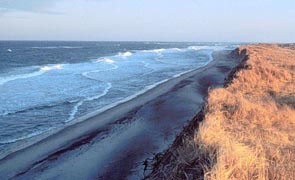 |
|
 |
Cape Cod is a large peninsula extending 60 miles into the Atlantic ocean from the coast of Massachusetts. Located on the outer portion of the Cape, Cape Cod National Seashore’s 44,600 acres encompass a rich mosaic of marine, estuarine, fresh water, and terrestrial ecosystems. These systems and their associated habitats reflect the Cape’s glacial origin, dynamic natural processes, and at least 9,000 years of human activity. Geomorphic shoreline change, ground water fluctuations, tidal dynamics including rising sea level, and atmospheric deposition are among the many physical processes that continue to shape the Seashore’s ecosystems. Marine and estuarine systems include beaches, sand spits, tidal flats, salt marshes, and soft-bottom benthos. Freshwater ecosystems include kettle ponds, vernal pools, sphagnum bogs, and swamps. Terrestrial systems include pitch pine and scrub oak forests, heathlands, dunes, and sandplain grasslands. Many of these habitats are globally uncommon and the species that occupy them are correspondingly rare.
Links:
Cape Cod National Seashore Prototype Long-Term Ecosystem Monitoring Program
|






